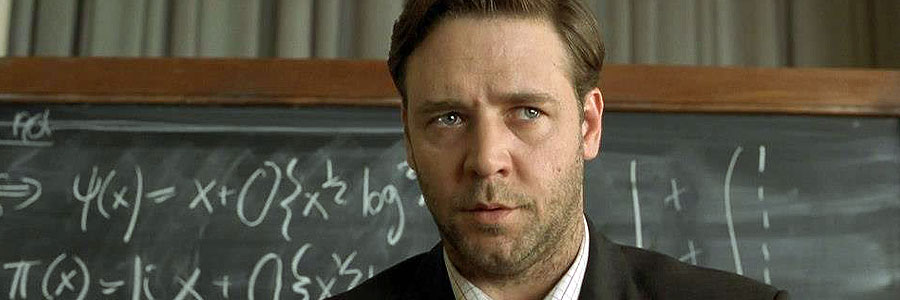
A Beautiful Mind
Universal Pictures
Original release: December 21, 2001
Running time: 135 minutes
Director: Ron Howard
Writers: Akiva Goldsman, Sylvia Nasar
Composer: James Horner
Cast: Russell Crowe, Ed Harris, Jennifer Connelly, Paul Bettany, Judd Hirsch, Josh Lucas, Christopher Plummer
Nash equilibrium: 00:19:00 to 00:21:46
Deconstructing Cinema: One Scene At A Time, the complete series so far
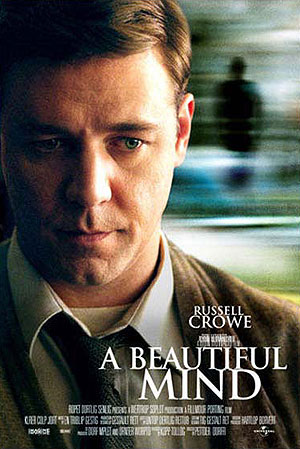
They say God works in mysterious ways, and the same can be said for the human mind. Performing vast amounts of complex functions every moment of our lives, many of which we’re never even consciously aware of. Our abilities to think, reason, perceive and form judgements are all characteristics associated with our beautiful minds, but are some more beautiful than others?
Based on the biography of John Nash by Sylvia Nasar, A Beautiful Mind tells the story of real-life mathematician John Nash (Russell Crowe) who was awarded the Nobel Prize in economics in 1994 for developing the Nash equilibrium. The film covers the time from when he was studying at Princeton University in 1947 through to when he went to work for MIT. It also touches on Nash’s struggle with schizophrenia and his relationship with his student Alicia (Jennifer Connelly), whom he eventually marries.
After having received the prestigious Carnegie Scholarship for mathematics and starting at Princeton, Nash meets a group of other promising math and science graduate students including Richard Sol (Adam Goldberg), Ainsley (Jason Gray-Stanford), and Bender (Anthony Rapp), along with Martin Hansen (Josh Lucas), the co-recipient of the scholarship. He also begins an unlikely friendship with his roommate Charles Herman (Paul Bettany), a literature student.
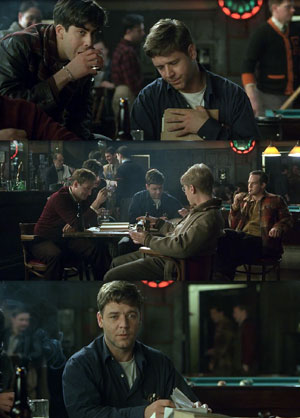
Though under pressure to publish, Nash is determined to hold back until he has a truly original idea, which finally comes to him one night when the group are discussing how to approach women at a bar. While Hansen quotes Adam Smith’s line “every man for himself”, Nash argues that a cooperative approach would lead to better chances of success and this spawns a new concept of governing dynamics (known as the Nash Equilibrium), which he goes on to publish. This leads to a post at MIT where he’s joined by Sol and Bender.
The scene presents us with just one scenario that’s available for all participants, but not one that might be best for all. Given that the blond provides a higher pay-off, would it not be perfectly within the rules if one member of the group deviates and goes for her, since he will have no competition, as suggested by one of Nash’s classmates? In a Nash equilibrium, no players would be able to have a strictly profitable deviation given what the others are doing.
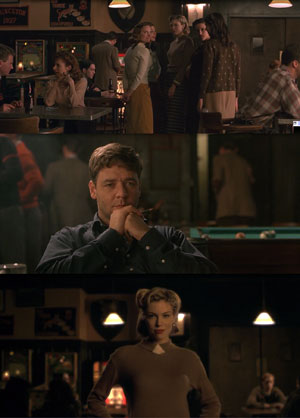
If Nash equilibrium can be defined as a stable state of a system that involves several interacting participants in which no participant can gain by a change of strategy as long as all the other participants remain unchanged, then we’d have to say that deviation breaks the rule and disrupts the stability. But why aren’t the brunettes and the blond included in the Nash equilibrium as participants?
It’s just one of the many thoughts that come to mind when watching this scene play out, and one of the many highlights in what’s truly a beautiful film to experience. Films based on real-life geniuses often go on to show how their abilities fit into their lives and the lives of people around them. A Beautiful Mind excels on all counts as we see how Nash’s abilities become marred by the onset of his schizophrenia.
While at MIT, he’s approached by William Parcher (Ed Harris) from the United States Department of Defense and asked to look for patterns in magazines and newspapers in order to thwart a Soviet plot. After having cracked encrypted enemy telecommunication mentally over at the Pentagon, much to the astonishment of other codebreakers, this shouldn’t be too difficult for him, but he becomes obsessed with searching for hidden patterns and starts to believe he’s being followed when he delivers his results to a secret mailbox.
Feeling his life might be in danger after witnessing a shootout between Parcher and Soviet agents, he tries to end his covert work, but they’re unwilling to let him and blackmail him to keep on. Things come to a head while delivering a guest lecture at Harvard University and he tries to flee when he sees foreign agents, led by Dr. Rosen (Christopher Plummer), entering. Nash is forcibly sedated and sent to a psychiatric facility, which he then believes is run by the Soviets.
- [1] John F. Nash, Jr. – Autobiography
- [2] Walter Nicholson, Intermediate Microeconomics Cengage Learning
Nash also experiences difficulties in his marriage and the problems with his mental state add to this, resulting in Alicia threatening to leave with their child when he puts them both at risk with his behaviour. The film does make some deviations from the source material – Nash’s actual experiences – it goes on to offers us a story about love conquering all, despite all the obstacles thrown in its path.
Featuring a powerful performance by Russell Crowe, an Oscar winning performance from Jennifer Connelly as Nash’s wife and a captivating and emotional score from James Horner, A Beautiful Mind brings us the life and struggles of a man whose work in game theory, differential geometry, and partial differential equations have provided insight into the forces that govern chance and events inside complex systems in daily life. His theories have been applied to market economics, computing, evolutionary biology, artificial intelligence, accounting, politics and military theory.
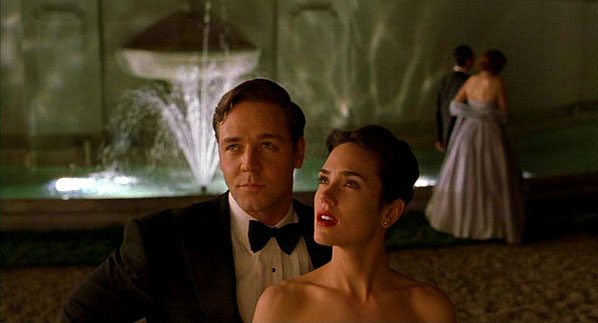

Patrick Samuel
The founder of Static Mass Emporium and one of its Editors in Chief is an emerging artist with a philosophy degree, working primarily with pastels and graphite pencils, but he also enjoys experimenting with water colours, acrylics, glass and oil paints.
Being on the autistic spectrum with Asperger’s Syndrome, he is stimulated by bold, contrasting colours, intricate details, multiple textures, and varying shades of light and dark. Patrick's work extends to sound and video, and when not drawing or painting, he can be found working on projects he shares online with his followers.
Patrick returned to drawing and painting after a prolonged break in December 2016 as part of his daily art therapy, and is now making the transition to being a full-time artist. As a spokesperson for autism awareness, he also gives talks and presentations on the benefits of creative therapy.
Static Mass is where he lives his passion for film and writing about it. A fan of film classics, documentaries and science fiction, Patrick prefers films with an impeccable way of storytelling that reflect on the human condition.
© 2022 STATIC MASS EMPORIUM . All Rights Reserved. Powered by METATEMPUS | creative.timeless.personal. | DISCLAIMER, TERMS & CONDITIONS
HOME | ABOUT | CONTACT | TWITTER | GOOGLE+ | FACEBOOK | TUMBLR | YOUTUBE | RSS FEED
CINEMA REVIEWS | BLU-RAY & DVD | THE EMPORIUM | DOCUMENTARIES | WORLD CINEMA | CULT MOVIES | INDIAN CINEMA | EARLY CINEMA
MOVIE CLASSICS | DECONSTRUCTING CINEMA | SOUNDTRACKS | INTERVIEWS | THE DIRECTOR’S CHAIR | JAPANESE CINEMA





